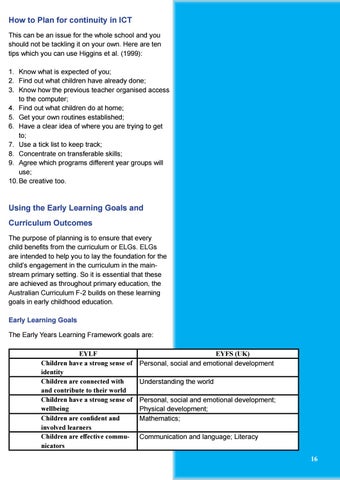How to Plan for continuity in ICT This can be an issue for the whole school and you should not be tackling it on your own. Here are ten tips which you can use Higgins et al. (1999): 1. Know what is expected of you; 2. Find out what children have already done; 3. Know how the previous teacher organised access to the computer; 4. Find out what children do at home; 5. Get your own routines established; 6. Have a clear idea of where you are trying to get to; 7. Use a tick list to keep track; 8. Concentrate on transferable skills; 9. Agree which programs different year groups will use; 10. Be creative too.
Using the Early Learning Goals and Curriculum Outcomes The purpose of planning is to ensure that every child benefits from the curriculum or ELGs. ELGs are intended to help you to lay the foundation for the child’s engagement in the curriculum in the mainstream primary setting. So it is essential that these are achieved as throughout primary education, the Australian Curriculum F-2 builds on these learning goals in early childhood education. Early Learning Goals The Early Years Learning Framework goals are: EYLF Children have a strong sense of identity Children are connected with and contribute to their world Children have a strong sense of wellbeing Children are confident and involved learners Children are effective communicators
EYFS (UK) Personal, social and emotional development Understanding the world Personal, social and emotional development; Physical development; Mathematics; Communication and language; Literacy 16











